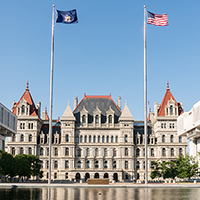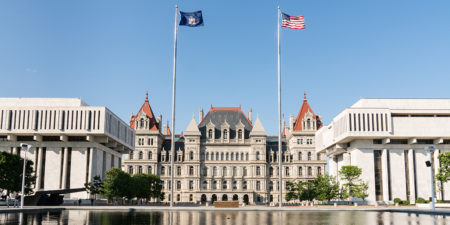PCDC: Protect Critical 340B Savings that Help Providers Serve New York’s Most Vulnerable Communities



In a letter to New York Governor Andrew Cuomo, PCDC stressed the devastating impact the proposed Medicaid pharmacy benefit transition will have on safety net providers across the state. The pharmacy transition from Medicaid managed care to fee-for-service, otherwise known as the “carve out,” is set to take effect on April 1, 2021, and would effectively eliminate the critical savings safety net providers receive through the federal 340B drug pricing program. The letter emphasized the damaging effects the loss of program savings will have on 340B providers – often referred to as “340B covered entities” – from a capital financing perspective. PCDC has been a long time lender to many 340B entities in the Empire State. “We know that lenders rely on the financial stability of an organization and reliability of its funding,” said PCDC. At a time when revenues are already drastically reduced due to the pandemic’s effects, PCDC argues the carve out will only further threaten these providers’ financing stability, which has negative downstream effects on the health of the patients they serve. “While uncertainty is always bad for investment, it is especially harmful to the health of New Yorkers.”
Read the full letter below.
December 23, 2020
RE: Medicaid Pharmacy Transition from Managed Care to Fee-for-Service
Dear Governor Cuomo:
We are writing to express our strong opposition to the state’s decision to transition the Medicaid pharmacy benefit out of managed care and into fee-for-service (FFS).
As a nonprofit U.S. Treasury-certified community development financial institution (CDFI) dedicated to creating healthier, more equitable communities across New York State, Primary Care Development Corporation (PCDC) shares your desire to more efficiently pay for health care services. However, we are deeply concerned by the pharmacy benefit “carve out,” which would eliminate critical 340B savings that enable health care providers who serve New York’s low-income communities to operate and provide services for the most vulnerable.
Elimination of 340B Savings Destabilizes Health Center Financing
Since PCDC’s founding in 1993, we have provided capital financing and technical assistance to over 950 health care sites in the Empire State. In just the last five years, PCDC arranged nearly $75 million in affordable and flexible financing to expand access to primary care across New York. As a lender to many 340B entities, PCDC is highly aware that 340B savings are, in many cases, a vital financial lifeline for safety net providers. PCDC understands how lenders assess risk and make decisions on where to invest capital. Even before the COVID-19 pandemic and resulting financial hardships, access to capital was limited for health centers and other safety net providers. We know that lenders rely on the financial stability of an organization and the reliability of its funding. The uncertainty imposed on the market by recent regulatory changes, including the “carve out,” in addition to the impact of COVID-19 and the resulting economic crisis, increases perceived and real risks associated with financing health centers and other safety net providers. This consequently may jeopardize their financial stability as well as their access to capital. This outcome is damaging for these providers at a time when revenues have already decreased drastically due to the pandemic’s effects.
The savings providers secure through the 340B program have served as a stable component of providers’ comprehensive revenues that lenders have historically relied upon when evaluating the financial sustainability of the organization and their ability to manage debt. This financial sustainability enables CDFIs like PCDC to offer more affordable interest rates and terms, attracting additional private investment from traditional financing institutions – ultimately reducing costs for the provider in the long term and opening financing avenues for future expansions and improvements.
Over the next months and years, safety net facilities will need even greater access to capital to fund COVID-19 related expenses to recruit and train furloughed staff in new delivery methods, redesign patient flow and facilities to accommodate new protocols for onsite care, invest in technology to support telehealth, implement a “bimodal” (physical onsite/virtual) primary care delivery platform, purchase personal protective equipment (PPE), and fund ancillary operating costs associated with patient service delivery. Constant debate and unpredictability surrounding 340B revenue will prove corrosive, undermining the sector’s stability, provoking partners and investors to reduce capital investment, and eroding the health center landscape when it is needed most. While uncertainty is always bad for investment, it is especially harmful to the health of New Yorkers.
Revenue Reduction Jeopardizes Community Health as Well as Local Economies
From our experience expanding and enhancing quality primary care in low-income communities, we have an intimate knowledge of how health centers and safety net providers rely on the 340B discount pharmacy program to invest in access to care for hard to reach and underserved patients. Since Congress enacted the 340B program in 1992, safety net providers have counted on 340B to reduce drug costs and help offset the high costs of delivering comprehensive care services to the medically underserved. Much of the care being delivered at these entities is unreimbursed due to the high proportion of medically needy patients who are underinsured or uninsured. The 340B program allows providers to fund the care and ancillary services that ultimately keep a community healthy rather than just triaging those with immediate need. Because health centers with 340B pharmacies inherently see the most vulnerable populations, reductions in the program’s savings are detrimental to the physical, mental, and economic health of the communities they serve. This leads to worsened health outcomes and could cause additional damage to local economies: health centers and other health care facilities are core community institutions that provide comprehensive care, maintaining the health of community populations, thereby maximizing employment productivity; and creating employment opportunities themselves.
The proposal to allow physician-administered drugs to remain “carved in” to the managed care pharmacy benefit does not do enough to protect all covered entities. This will predominantly benefit safety net hospitals and leave out community health centers that rarely administer these drugs. These health centers are critical care access points during the COVID-19 pandemic. The Community Health Center Association of New York (CHCANYS) projects at least $100 million in losses as a result of this transition. At a time when the state’s most vulnerable populations are suffering disproportionately as a result of the pandemic and economic crisis, they cannot afford to lose the vital services that community health centers provide. Repercussions are also economical: worse health outcomes correlate with exits from the workforce, whether temporary or permanent. In addition, downsizing or shuttering community health centers and critical access hospitals can have significant negative effects on an area’s fiscal health.
While the overall goal of lowering drug costs is critically important, the impact of transitioning the pharmacy benefit to FFS on 340B covered entities, and the communities they serve will be catastrophic. We urge you to consider the detrimental effects of the transition on the health and stability of New York’s most vulnerable communities.
Primary Care Development Corporation (PCDC)
Patrick Kwan, Senior Director of Advocacy and Communications
(212) 437-3927 | pkwan@pcdc.org